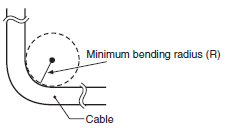 Cautions
Cautions
-
 Sensors
Sensors
-
 Fiber Sensors
Fiber Sensors
-
 Photoelectric Sensors
Photoelectric Sensors
-
 Displacement Sensors / Measurement Sensors
Displacement Sensors / Measurement Sensors
-
 Proximity Sensors
Proximity Sensors
-
 Photomicro Sensors
Photomicro Sensors
-
 Rotary Encoders
Rotary Encoders
- Pressure Sensors / Flow Sensors
-
 Ultrasonic Sensors
Ultrasonic Sensors
-
Pressure Sensors / Flow Sensors
|
|
|
|
| Safety Precautions |

These products cannot be used in safety devices for presses or other safety devices used to protect human life. These products are designed for use in applications for sensing workpieces and workers that do not affect safety.


Withstand Pressure
Do not apply a pressure higher than the rated withstand pressure.
Applying a pressure higher than this may cause damage.
Operating Environment
Do not use the products in an environment where there are explosive or inflammable gases.
Power Supply Voltage
Do not use a voltage that exceeds the power supply voltage range.
Using a voltage that exceeds the range may cause burning.
Load Short-circuiting
Do not short-circuit the load. Doing so may cause explosion or burning.
Incorrect Wiring
Be sure that the power supply polarity and other wiring is correct.
Incorrect wiring may cause explosion or burning.

• When using a Sensor that supports non-corrosive gas as the applicable fluid, use an air filter to remove moisture and oil from the gas.
• Do not insert any wire or other object into the pressure port. Doing so may damage the pressure elements and cause a malfunction.
• Mount the Sensor so that it is not subject to ultrasonic vibration.
• The cable can be extended to a maximum of 10 m. For details, see the output impedance section on the previous page.
Bending the Cable
If you need to bend the cable, we recommend a bend radius that is at least 3 times the outer diameter of the cable. (For coaxial, shielded and robot cables, at least 5 times the outer diameter of the cable is recommended.)
The minimum bending radius is specified as the radius of the inside surface of the cable bend.

Cable Tensile Strength
When wiring the cable, do not subject the cable to a tension greater than that indicated in the following table.
| Cable diameter | Tensile strength |
| Less than 4 mm | 30 N max. |
| 4 mm or greater | 50 N max. |
Note: Do not subject a shielded cable or coaxial cable to tension.
Cable
The insulated part of the cable terminal is used for our internal characteristic inspections. This section is not covered by our warranty. Please cut and process the insulated part of the cable terminal (brown, blue, black, etc.) before use.
Separation from High Voltage (Wiring Method)
Do not lay the cables for the Sensor together with high-voltage lines or power lines. Placing them in the same conduit or duct may cause damage or malfunction due to induction interference. As a general rule, wire the Sensor in a separate system, use an independent metal conduit, or use shielded cable.
